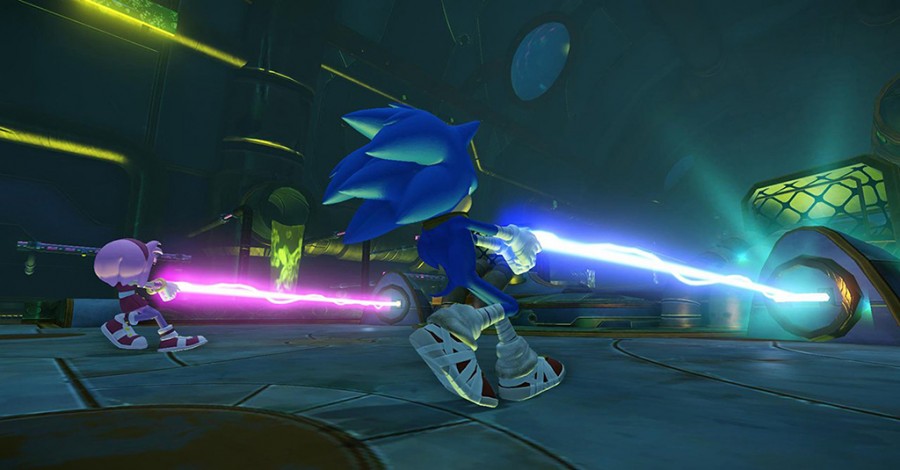Why Video Game Sound Is So Powerfully Bonding
September 9, 2014
By Brian Crecente
McClatchy-Tribune News Service
Nostalgia sometimes comes in a thick soup of buzzes, beeps, trills and, of course, wakka-wakkas.
That cacophony of sounds paint an audio landscape that any child of the 70s’, 80s’ or 90s’ can pick up in an instant: The arcade.
It is so specific, so sentimental of a time when people traded quarters for a few minutes of digital escape, that soundtracks have been created. Soundtracks not just of an arcade, but arcades by year. The sounds of a 1981 arcade, for instance, might include the upbeat audio kaleidoscope of Crazy Climber, Mouse Trap, Space Invaders and Donkey Kong. But if you listen to the sounds of a 1992 arcade you’ll be listening to the rhythmic thrum of Street Fighter 2, Mortal Kombat, even pinball machines like Black Knight and Elvira.
Music and sound are as important an element of gaming as the filmic visuals of video games and the mechanics that drive play, and now they’re getting their own documentary and book.
Beep: A Documentary History of Video Game Music and Sound is being launched via a Kickstarter out of Toronto. The documentary, book and website promise to explore the full history of sound in games. The project will start with the metallic taps of Victorian-era mechanical arcades and move through to pinball machines, to the early beep-boop sounds of the progenitors of arcade games and finally to today’s symphonic extravaganzas.
“We’re going to explore how music changes, the psychology of audio, how it’s integrated into games and who’s using games to make their own music,” said Karen Collins, Canada research chair in interactive audio at the University of Waterloo and director of the project. “Most of us can hum a game’s song, we know the themes, but ask someone who wrote those songs and we don’t know their names.”
That is one reason why this documentary is being made.
Collins started her research into video game music and sound more than 15 years ago. She said she was halfway through writing her PhD on industrial music when she started to notice that there were a lot of similarities between it and some video games.
“It struck me that video games had the same tonality and that no one was looking at video game music,” she said. “This is something that needs to be looked at. The people who are doing it are so talented and they just don’t get the credit they deserve.”
Her project has attracted the attention of some of the best audio and music people in gaming with more than 50 musicians and audio experts already signed up for interviews, and broad industry support for the idea.
Brian Schmidt, executive director of the GameSoundCon convention, said that music and audio in games serve a lot of different purposes, some obvious, some not so.
“From a player perspective, music can kind of manipulate you,” said Schmidt, who created sound for a number of pinball machines and arcade games including Hook andNARC. “Music can really pull at your strings and get you going in the direction the game designer wants you to get going.”
Sound can also be used to inform players, he said. For instance, when a player has a power-up, the audio might change until the power is gone. Or if a player is dying, the audio might change to note that.
“You can both play with the emotions of a player in a subtle way and also directly inform them about what’s going on,” he said.
Finally, audio and music is a great branding tool for games, he said.
“Everyone can hum the Mario theme,” Schmidt said. “If you start to sing the monks from the Halo theme, everyone will sing along with you.
“It helps make game sticky. It lets you latch on to something that isn’t visual.”
Even old arcade games were able to emotionally manipulate gamers.
Asteroids, the 1979 black and white vector graphics game, relied on a very simple set of background beeps as its soundtrack, but that simple sound became a sort of touchstone for modern composers looking to make interactive video game music.
“You have this underlying do-do-do, do-do-do,” Schmidt said. “As time went on, it would speed up. It has a beat around the same speed as the human heart rate. When it speeds up, you can’t help but have a physiological response.”
That ability to deliver emotion to a player through sound didn’t start with computer-generated audio. For decades, mechanical audio did the same thing. But in modern games there are very few holdovers from that old style of sound. The one exception might be the pinball machine.
“Pinball machines have a great way to let players in a noisy arcade boast,” Schmidt said. “When someone breaks a high score or gets a jackpot it makes a big noise.”
That jolting crack, called the knocker or free-game noise, is created by using a solenoid to physically drive a metal rod into the side of a pinball machine.
“Part of the reasons we needed to have a big noise like that was to get the attention of everyone else in the arcade.”
Collins push to document the sounds of games and the people who created them was driven in part by a realization that the music and the creators were starting to disappear.
“It’s a great time to document this stuff before we start to lose it,” she said.
Her hope is that in preserving this information she will be able to better educate gamers and perhaps attract a broader mainstream audience to the joys of gaming sound.
Tommy Tallarico, who has created audio for more than 250 games, spends 300 days a year serving as exactly that sort of ambassador to the gaming and non-gaming public. He kicked off the Video Games Live concert series in 2005 to introduce gamers to classic performances, and music lovers to video game soundtracks. Since its inception, the touring concert series, which features a live orchestra playing video game music, has been attended by more than 1.2 million people in venues around the world. In 2010, the New Orleans Video Games Live concert was taped and broadcast on PBS. Tallarico says the airing is the eighth most-viewed PBS music special of all time.
“The show is for everyone,” he said. “You don’t have to know a darn thing about video games to follow along. The reason I created the show was that I wanted to prove to the world how culturally significant video games have become. I wanted to get access to everyone. PBS was the epitome of that for me.”
Tallarico said he backed the Beep documentary and introduced it to his nonprofit video game music organization because he’s such a big believer in it.
“I think it’s fantastic,” he said. “It helps legitimize everything we do, not just video game music but the entire video game industry.”
He added that gaming music tends to be more beloved by those familiar with it then even the music that powers television or movies.
“The reason why people are so attached to video game music is because more so then any other music, when you play a video game you become that character, therefore the music we create becomes the soundtrack of your life.”
If the Kickstarter is fully backed, which seems very likely, Collins said she hopes to have the project completed by the end of next year and to start shipping the book and video by early 2016.
Tallarico hopes that the release will help to immortalize the sounds of games like Pac-Man, Space Invaders and Donkey Kong and also introduce it to a whole new generation of gamers, gamers who might only be familiar with modern titles like Minecraft and League of Legends.
“You have to represent the classics,” he said. “That’s what I love about the idea of the film.”
———
(Good Game is an internationally syndicated weekly news and opinion column about the big stories of the week in the gaming industry and its bigger impact on things to come. Brian Crecente is a founding news editor of Polygon.)
Distributed by MCT Information Services
















